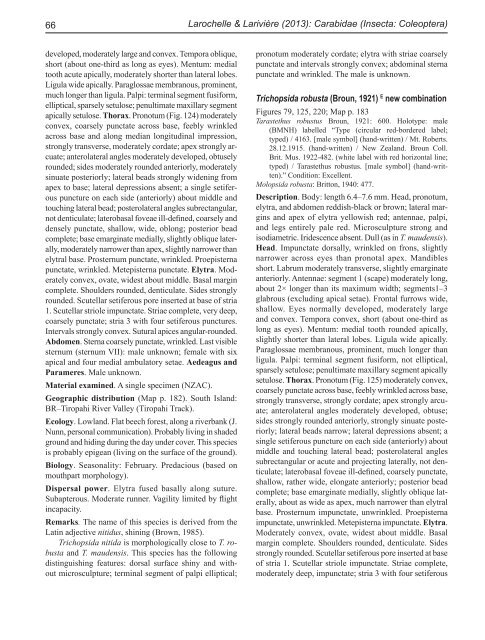Fauna of New Zealand 69 - Landcare Research
Fauna of New Zealand 69 - Landcare Research
Fauna of New Zealand 69 - Landcare Research
You also want an ePaper? Increase the reach of your titles
YUMPU automatically turns print PDFs into web optimized ePapers that Google loves.
66<br />
developed, moderately large and convex. Tempora oblique,<br />
short (about one-third as long as eyes). Mentum: medial<br />
tooth acute apically, moderately shorter than lateral lobes.<br />
Ligula wide apically. Paraglossae membranous, prominent,<br />
much longer than ligula. Palpi: terminal segment fusiform,<br />
elliptical, sparsely setulose; penultimate maxillary segment<br />
apically setulose. Thorax. Pronotum (Fig. 124) moderately<br />
convex, coarsely punctate across base, feebly wrinkled<br />
across base and along median longitudinal impression,<br />
strongly transverse, moderately cordate; apex strongly arcuate;<br />
anterolateral angles moderately developed, obtusely<br />
rounded; sides moderately rounded anteriorly, moderately<br />
sinuate posteriorly; lateral beads strongly widening from<br />
apex to base; lateral depressions absent; a single setiferous<br />
puncture on each side (anteriorly) about middle and<br />
touching lateral bead; posterolateral angles subrectangular,<br />
not denticulate; laterobasal foveae ill-defined, coarsely and<br />
densely punctate, shallow, wide, oblong; posterior bead<br />
complete; base emarginate medially, slightly oblique laterally,<br />
moderately narrower than apex, slightly narrower than<br />
elytral base. Prosternum punctate, wrinkled. Proepisterna<br />
punctate, wrinkled. Metepisterna punctate. Elytra. Moderately<br />
convex, ovate, widest about middle. Basal margin<br />
complete. Shoulders rounded, denticulate. Sides strongly<br />
rounded. Scutellar setiferous pore inserted at base <strong>of</strong> stria<br />
1. Scutellar striole impunctate. Striae complete, very deep,<br />
coarsely punctate; stria 3 with four setiferous punctures.<br />
Intervals strongly convex. Sutural apices angular-rounded.<br />
Abdomen. Sterna coarsely punctate, wrinkled. Last visible<br />
sternum (sternum VII): male unknown; female with six<br />
apical and four medial ambulatory setae. Aedeagus and<br />
Parameres. Male unknown.<br />
Material examined. A single specimen (NZAC).<br />
Geographic distribution (Map p. 182). South Island:<br />
BR–Tiropahi River Valley (Tiropahi Track).<br />
Ecology. Lowland. Flat beech forest, along a riverbank (J.<br />
Nunn, personal communication). Probably living in shaded<br />
ground and hiding during the day under cover. This species<br />
is probably epigean (living on the surface <strong>of</strong> the ground).<br />
Biology. Seasonality: February. Predacious (based on<br />
mouthpart morphology).<br />
Dispersal power. Elytra fused basally along suture.<br />
Subapterous. Moderate runner. Vagility limited by flight<br />
incapacity.<br />
Remarks. The name <strong>of</strong> this species is derived from the<br />
Latin adjective nitidus, shining (Brown, 1985).<br />
Trichopsida nitida is morphologically close to T. robusta<br />
and T. maudensis. This species has the following<br />
distinguishing features: dorsal surface shiny and without<br />
microsculpture; terminal segment <strong>of</strong> palpi elliptical;<br />
Larochelle & Larivière (2013): Carabidae (Insecta: Coleoptera)<br />
pronotum moderately cordate; elytra with striae coarsely<br />
punctate and intervals strongly convex; abdominal sterna<br />
punctate and wrinkled. The male is unknown.<br />
Trichopsida robusta (Broun, 1921) E new combination<br />
Figures 79, 125, 220; Map p. 183<br />
Tarastethus robustus Broun, 1921: 600. Holotype: male<br />
(BMNH) labelled “Type (circular red-bordered label;<br />
typed) / 4163. [male symbol] (hand-written) / Mt. Roberts.<br />
28.12.1915. (hand-written) / <strong>New</strong> <strong>Zealand</strong>. Broun Coll.<br />
Brit. Mus. 1922-482. (white label with red horizontal line;<br />
typed) / Tarastethus robustus. [male symbol] (hand-written).”<br />
Condition: Excellent.<br />
Molopsida robusta: Britton, 1940: 477.<br />
Description. Body: length 6.4–7.6 mm. Head, pronotum,<br />
elytra, and abdomen reddish-black or brown; lateral margins<br />
and apex <strong>of</strong> elytra yellowish red; antennae, palpi,<br />
and legs entirely pale red. Microsculpture strong and<br />
isodiametric. Iridescence absent. Dull (as in T. maudensis).<br />
Head. Impunctate dorsally, wrinkled on frons, slightly<br />
narrower across eyes than pronotal apex. Mandibles<br />
short. Labrum moderately transverse, slightly emarginate<br />
anteriorly. Antennae: segment 1 (scape) moderately long,<br />
about 2× longer than its maximum width; segments1–3<br />
glabrous (excluding apical setae). Frontal furrows wide,<br />
shallow. Eyes normally developed, moderately large<br />
and convex. Tempora convex, short (about one-third as<br />
long as eyes). Mentum: medial tooth rounded apically,<br />
slightly shorter than lateral lobes. Ligula wide apically.<br />
Paraglossae membranous, prominent, much longer than<br />
ligula. Palpi: terminal segment fusiform, not elliptical,<br />
sparsely setulose; penultimate maxillary segment apically<br />
setulose. Thorax. Pronotum (Fig. 125) moderately convex,<br />
coarsely punctate across base, feebly wrinkled across base,<br />
strongly transverse, strongly cordate; apex strongly arcuate;<br />
anterolateral angles moderately developed, obtuse;<br />
sides strongly rounded anteriorly, strongly sinuate posteriorly;<br />
lateral beads narrow; lateral depressions absent; a<br />
single setiferous puncture on each side (anteriorly) about<br />
middle and touching lateral bead; posterolateral angles<br />
subrectangular or acute and projecting laterally, not denticulate;<br />
laterobasal foveae ill-defined, coarsely punctate,<br />
shallow, rather wide, elongate anteriorly; posterior bead<br />
complete; base emarginate medially, slightly oblique laterally,<br />
about as wide as apex, much narrower than elytral<br />
base. Prosternum impunctate, unwrinkled. Proepisterna<br />
impunctate, unwrinkled. Metepisterna impunctate. Elytra.<br />
Moderately convex, ovate, widest about middle. Basal<br />
margin complete. Shoulders rounded, denticulate. Sides<br />
strongly rounded. Scutellar setiferous pore inserted at base<br />
<strong>of</strong> stria 1. Scutellar striole impunctate. Striae complete,<br />
moderately deep, impunctate; stria 3 with four setiferous
















